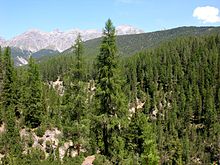Forest

A forest, an aa referred tae as a wid or the wids, is an aurie wi a heich density o trees. As wi ceeties, dependin on various cultural defineetions, what is considered a forest mey vary signeeficantly in size an hae different classifications accordin tae hou an o whit the forest is componed.[1] A forest is uisually an aurie filled wi trees but ony taw densely packed aurie o vegetation mey be considered a forest, even unnerwatter vegetation sic as kelp forests, or non-vegetation sic as fungi,[2] an bacteria. Tree forests kiver approximately 9.4 percent o the Yird's surface (or 30 percent o tot land aurie), tho thay ance covered much mair (aboot 50 percent o tot land aurie). Thay function as habitats for organisms, hydrologic flow modulators, an syle conservers, constitutin ane o the maist important aspects o the biosphere.
A teepical tree forest is componed o the owerstory (canopy or upper tree layer) an the unnerstory. The unnerstory is further subdividit intae the shrub layer, yerb layer, an an aa the moss layer an syle microbes. In some complex forests, thare is an aa a well-defined lawer tree layer. Forests are central tae aw human life acause thay provide a diverse range o resoorces: thay store carbon, aid in regulatin the planetary climate, purify watter an mitigate naitural hazards sic as fluids. Forests an aa contain roughly 90 percent o the warld's terrestrial biodiversity.[3]
References[eedit | eedit soorce]
- ↑ Lund, H. Gyde (coord.) 2006. 'Definitions of Forest, Deforestation, Afforestation, and Reforestation'. Gainesville, VA: Forest Information Services. Available from: ComcastNet-gyde.
- ↑ Stamets, Paul (2005). Mycelium Running. Ten Speed Press. p. 35. ISBN 1-58008-579-2.
- ↑ "Living Planet Report 2010". 2010. Retrieved 19 Apryle 2011. Cite journal requires
|journal=(help)
